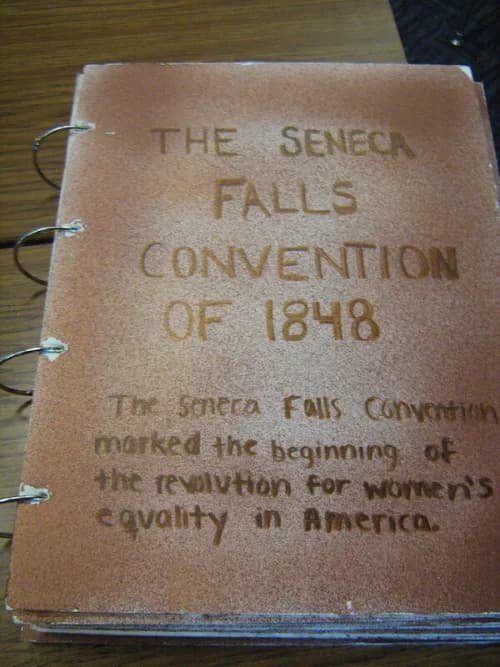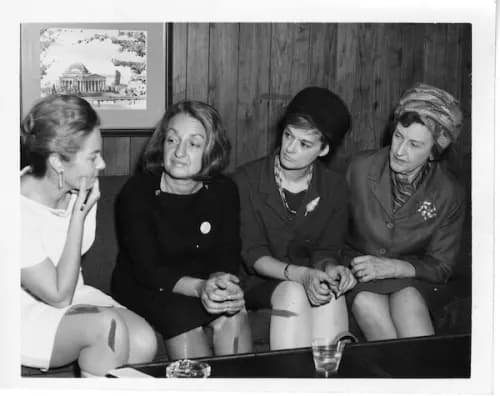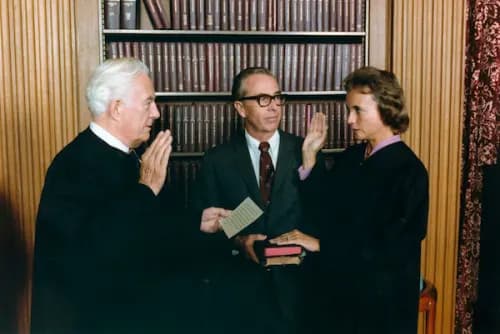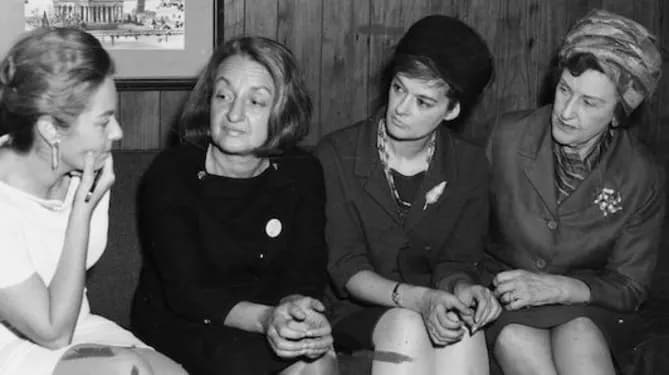All About the Women's Rights Movement
The women’s rights movement has a long and illustrious history in the United States. It’s impossible to pin down a precise starting point for the fight for women’s equality—did it begin with Abigail Adams’s plea to her husband, John Adams, for the founding father to “remember the ladies”? Or sooner still?—but many historians point to 1848, the year of the Seneca Falls Convention, as the moment when women began “officially” demanding their civil rights.
Below are major dates, people, and events that changed history for women and men alike.
1848–1920

1848: The Seneca Falls Convention.
In response to women being shut out of the 1840 World Anti-Slavery Convention in London, Elizabeth Cady Stanton, along with members of the M’Clintock family, drafted the Declaration of Sentiments, outlining 18 grievances to mirror the Declaration of Independence. The document included specific points about how women were disregarded legally in their own society.
Cady Stanton and Lucretia Mott, along with other important activists, organized the first women’s rights convention to take place in Seneca Falls, New York. At the Seneca Falls Convention, 68 women and 32 men signed the Declaration of Sentiments.
1850: The National Women's Rights Convention.
The first National Women’s Rights Convention was held in Worcester, Massachusetts. More than 1,000 people attended, and conventions continued to be held annually through 1860, with the exception of 1857.
1869: Establishment of the National Woman Suffrage Association and the American Woman Suffrage Association.
Two factions of the women’s rights movement emerged. Cady Stanton and Susan B. Anthony established the National Woman Suffrage Association to fight for a federal amendment granting women the right to vote. Meanwhile, Lucy Stone, Henry Blackwell, and other participants formed the American Woman Suffrage Association to champion women’s voting rights at the state level.
1869: First women's suffrage amendment.
Wyoming became the first U.S. territory to grant women the right to vote.
1887: First Senate vote on the women's suffrage amendment.
In a 16 to 34 vote, the U.S. Senate voted against adopting a federal women’s suffrage amendment.
1890: Formation of the National American Woman Suffrage Association.
The National Women Suffrage Association and the American Women Suffrage Association merged to become the National American Woman Suffrage Association (NAWSA), focusing on conducting state campaigns for women’s suffrage.
1893–1896: Further women's suffrage amendments.
Three more states granted women the right to vote before 1910: Colorado in 1893 and Utah and Idaho in 1896. (Wyoming was a territory when it passed its women’s suffrage amendment and became a state in 1890).
1896: Formation of the National Association of Colored Women.
Black women’s rights advocates formed the National Association of Colored Women (NACW), bringing together more than 100 local clubs. Mary Church Terrell served as the organization’s first president.
1900: Women's rights to property and wages.
Every state in the U.S. passed legislation granting women the right to keep the wages they earned and own their own property by this point.
1910–1918: Further women's suffrage amendments.
Thirteen more states passed amendments granting women the right to vote: Washington (1910); California (1911); Oregon, Kansas, and Arizona (1912); Alaska and Illinois (1913); Montana and Nevada (1914); New York (1917); and Michigan, South Dakota, and Oklahoma (1918).
1913: Formation of the Congressional Union.
Alice Paul and Lucy Burns established the Congressional Union, later renamed the National Women’s Party, to campaign for a federal amendment granting women the right to vote. Members of the group picketed the White House and organized an 8,000-person march on Washington on the eve of Woodrow Wilson’s inauguration.
1914: First vote on the women's suffrage amendment.
Motivated in part by efforts from the Congressional Union, the Senate voted on the women’s suffrage amendment for the first time since 1887 and rejected it.
1916: First birth-control clinic.
Margaret Sanger opened the first birth-control clinic in the U.S. in Brooklyn. She was arrested 10 days after opening the clinic but was eventually able to reestablish her clinic in Manhattan in 1923.
1916: The first congresswoman is elected.
Montana became the first state to elect a woman, Jeanette Rankin, to the House of Representatives.
1918: House passage of the women's suffrage amendment.
On January 10, 1918, the House of Representatives passed the women’s suffrage amendment by one vote. The amendment failed by two votes in the Senate.
1919: Senate passage of the women's suffrage amendment.
In 1919, the amendment was proposed again in the Senate and failed by one vote.
President Wilson called a special session to return the proposal to the House floor, where it passed by a large margin of 42 votes. On June 4, 1919, the Senate passed the amendment with 56 ayes and 25 nayes.
1920: Ratification of the 19th Amendment to the Constitution.
On August 18, 1920, Tennessee ratified the 19th Amendment by one vote, becoming the final state to ratify the amendment. On August 26, Secretary of State Bainbridge Colby signed the amendment into law, granting women the right to vote throughout the U.S.
1920–1960s

1923: Introduction of the Equal Rights Amendment.
Alice Paul drafted the Equal Rights Amendment, calling it the “Lucretia Mott Amendment,” which stated that men and women would have equal rights throughout the U.S.
1932: First female senator.
Arkansas’s Hattie Wyatt Caraway became the first woman to be elected to the U.S. Senate.
1933: First female cabinet member.
Appointed by Franklin D. Roosevelt, Frances Perkins became the first woman to hold a seat in the presidential cabinet as secretary of labor.
1936: Declassification of birth control as "obscene".
The Supreme Court rendered a decision declaring birth control legal under medical direction.
1960s and 1970s

1961: President's Commission on the Status of Women.
At the suggestion of Esther Peterson, the assistant secretary of labor and director of the Women’s Bureau, President John Kennedy formed the President’s Commission on the Status of Women. He appointed Eleanor Roosevelt to chair the Commission and made proposals and recommendations for improvement in areas related to employment policy, education, and other laws.
1963: Equal Pay Act.
President Kennedy signed into law the Equal Pay Act, which required private employers to pay employees equitable wages for the same work under the same conditions regardless of race, color, religion, national origin, or sex.
1963: The Feminine Mystique.
Betty Friedan published The Feminine Mystique, in which she argued that women deserved more than the traditional roles they had thus far occupied. Her influential book is credited for initiating the second wave of feminism in the U.S.
1964: Civil Rights Act.
Congress passed the Civil Rights Act, including Title VII, which prohibited employment discrimination on the basis of race, color, religion, national origin, or sex.
The Equal Employment Opportunity Commission, which was established to take action regarding complaints about violations of Title VII, received 50,000 sex discrimination complaints within five years of its passage.
1965: Griswold v. Connecticut
The Supreme Court overturned Connecticut’s law prohibiting the use of contraceptives by married couples.
1966: National Organization for Women.
Feeling that the EEOC was not taking sex discrimination complaints seriously, Betty Friedan and other feminists formed the National Organization for Women (NOW) to fight against sex discrimination. Its focal effort was bringing the Equal Rights Amendment back into the national foreground.
1967: Executive Order 11375.
President Lyndon B. Johnson expanded his previous affirmative action policy, Executive Order 11246, to include gender-based discrimination, stating that federal agencies and contractors are required to take active measures to grant women and minorities equitable educational and employment opportunities like white men.
1972: Title IX.
Title IX of the Education Amendment passed, prohibiting sex discrimination in federally-supported schools and education programs, leading to a dramatic increase in the enrollment of women in professional school and sports programs.
1972: Equal Rights Amendment Reintroduction.
As a result of the women’s rights movement, in particular efforts by NOW, the ERA was sent to and passed by Congress, which placed a deadline of March 22, 1979, on the ratification process.
By 1977, 35 of the required 38 states had ratified the ERA. In 1978, Congress extended the deadline to June 30, 1982. No further states ratified the amendment until 2017, and four states voted to retract their ratifications.
1973: Roe v. Wade.
In a landmark 7-2 ruling, the Supreme Court granted women the right to have legal abortions throughout the U.S.
1978: Pregnancy Discrimination Act.
Amending Title VII of the Civil Rights Act of 1964, the Pregnancy Discrimination Act prohibited firing or denying access to employment or promotions on the basis of current or future pregnancy. The Act also states that a pregnant woman cannot be forced to take maternity leave if she is willing and able to work.
1980s and 1990s

1981: First woman Supreme Court justice.
In a unanimous Senate vote, Sandra Day O’Connor was confirmed as the first female U.S. Supreme Court justice, nominated by President Ronald Reagan.
1982: Equal Rights Amendment ratification failure.
At its extended deadline, the ERA failed to achieve the 38 state ratifications that needed to be signed into law.
1984: First female vice presidential candidate.
Geraldine Ferraro became the first woman to be nominated as a vice presidential candidate. She ran with Democratic candidate Walter Mondale.
1992: The Year of the Woman.
Following the Senate confirmation hearings for Supreme Court nominee Clarence Thomas, in which Anita Hill accused the future SCOTUS justice of sexual harassment, record numbers of women were elected to Congress. Patty Murray, Barbara Boxer, Dianne Feinstein, and Carol Moseley Braun joined Barbara Mikulski and Nancy Kassebaum as female Senate members, while 24 women were elected to the House of Representatives. The explosion of female representation led to 1992 being deemed “The Year of the Woman.”
1994: Violence Against Women Act.
Signed into law by President Bill Clinton, the Violence Against Women Act established the funding of services for violent crimes against women and imposed mandatory sentences on convicted perpetrators. The Act also entitled women to seek civil redress in unprosecuted cases, but this measure was later revoked.
This Act also led to the creation of the Department of Justice’s Office on Violence Against Women.
1997: First female secretary of state.
Appointed by President Clinton, Madeleine Albright became the first female secretary of state.
2000s and 2010s

2004: Partial-Birth Abortion Ban Act.
Passed by Congress and upheld by the Supreme Court four years later, the Partial-Birth Abortion Ban Act prohibited a specific form of late-term abortion involving “intact dilation and extraction.” It was the first law to prohibit a specific abortion procedure.
2007: First female Speaker of the House.
After Democrats took control of the House of Representatives in the 2006 midterm elections, Nancy Pelosi, then the House Minority Leader, became the first woman Speaker of the House.
2009: The Lily Ledbetter Fair Pay Restoration Act.
The first bill signed into law by President Barack Obama, the Lily Ledbetter Fair Pay Restoration Act, named for an Alabama woman who accused her employer of paying her less than her male coworkers, protected people who faced pay discrimination by allowing them to file complaints against their employers within 180 days of their last paycheck.
2013: Women in military combat positions ban removal.
Overturning a 1994 Pentagon decision that prevented women from serving in combat, a ban against women in military combat positions was removed.
2016: First woman presidential nominee of a major party.
Hillary Rodham Clinton, the former secretary of state under President Obama and previously a New York senator secured the presidential nomination of the Democratic Party, becoming the first woman presidential nominee leading a major party in the U.S. Securing a majority percentage of the popular vote, she was defeated by now-President Donald Trump on November 8, 2016, who received 303 electoral votes to Clinton’s 232.
2017: Women's March on Washington.
On January 21, 2017 people across the world participated in the largest women’s rights demonstration to date. The event was originally planned as the Women’s March in Washington, DC, and affiliated marches were held on all seven continents. The March followed the inauguration of President Donald Trump as a response to his anti-women rhetoric, with advocates also championing issues such as human rights, health care reform, and other causes.
2017–present day: The Me Too Movement.
Following accusations of sexual harassment, violence, and assault against Harvey Weinstein and many other high-profile men, Alyssa Milano popularized #MeToo on social media, encouraging women to share their stories of sexual harassment and abuse. Tarana Burke coined the phrase in the mid-2000s. The idea gained widespread support and became a worldwide movement against sexual violence.
California Congresswoman Jackie Speier proposed the Member and Employee Training and Oversight on Congress Act (ME TOO) as a means of improving the sexual harassment complaint process in the legislative branch to protect complainants.
Since then, numerous high-profile men in positions of power have been accused of sexual harassment and misconduct around the world. The TIME’s UP legal Defense Fund was established to provide legal support to victims and survivors.
The Women's Rights Movement: The Battle Continues
It’s clear that the women’s rights movement is far from over. The Me Too Movement has brought violence against women to the forefront of the national conversation, and the fight against gender discrimination in the workplace and other spheres continues. Support for the ERA has resurged in recent years, and threats to women’s rights are cropping up—and being challenged by organizations such as Planned Parenthood and the ACLU—every day.
--
Why women love us:
- Daily articles on career topics
- Jobs at companies dedicated to hiring more women
- Advice and support from an authentic community
- Events that help you level up in your career
- Free membership, always
